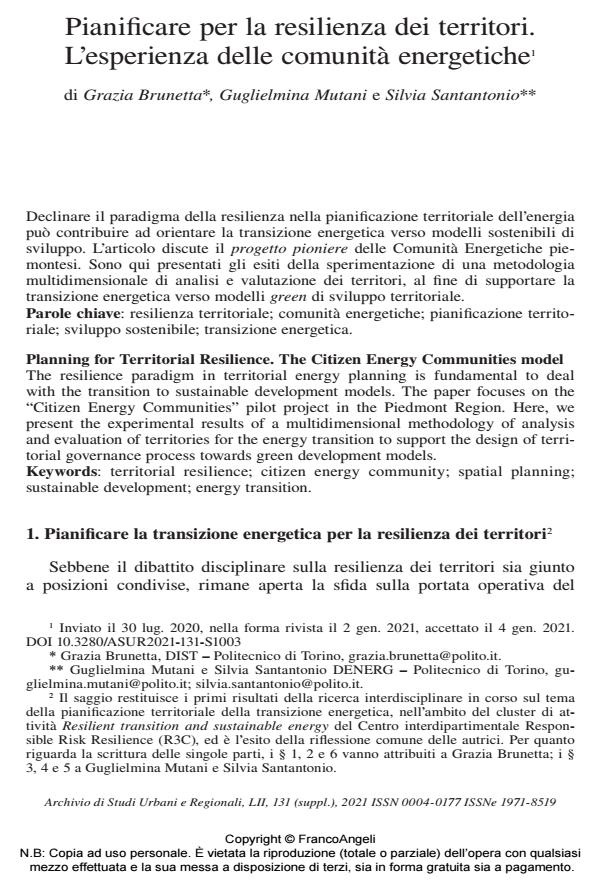Pianificare per la resilienza dei territori. L’esperienza delle comunità energetiche
Titolo Rivista ARCHIVIO DI STUDI URBANI E REGIONALI
Autori/Curatori Grazia Brunetta, Guglielmina Mutani, Silvia Santantonio
Anno di pubblicazione 2021 Fascicolo 2021/suppl. 131
Lingua Italiano Numero pagine 27 P. 44-70 Dimensione file 274 KB
DOI 10.3280/ASUR2021-131-S1003
Il DOI è il codice a barre della proprietà intellettuale: per saperne di più
clicca qui
Qui sotto puoi vedere in anteprima la prima pagina di questo articolo.
Se questo articolo ti interessa, lo puoi acquistare (e scaricare in formato pdf) seguendo le facili indicazioni per acquistare il download credit. Acquista Download Credits per scaricare questo Articolo in formato PDF

FrancoAngeli è membro della Publishers International Linking Association, Inc (PILA)associazione indipendente e non profit per facilitare (attraverso i servizi tecnologici implementati da CrossRef.org) l’accesso degli studiosi ai contenuti digitali nelle pubblicazioni professionali e scientifiche
Declinare il paradigma della resilienza nella pianificazione territoriale dell’energia può con-tribuire ad orientare la transizione energetica verso modelli sostenibili di sviluppo. L’articolo discute il progetto pioniere delle Comunità Energetiche piemontesi. Sono qui presentati gli esiti della sperimentazione di una metodologia multidimensionale di analisi e valutazione dei territori, al fine di supportare la transizione energetica verso modelli green di sviluppo territoriale.
Parole chiave:resilienza territoriale; comunità energetiche; pianificazione territoriale; svi-luppo sostenibile; transizione energetica.
- Computational Science and Its Applications – ICCSA 2024 Workshops Becchio Cristina, Bottaccioli Lorenzo, Bottero Marta, Cavana Giulio, Fancello Giovanna, Sciullo Alessandro, pp.207 (ISBN:978-3-031-65307-0)
- Computational Science and Its Applications – ICCSA 2025 Workshops Alessandra Marra, Michele Grimaldi, Isidoro Fasolino, Monica M. L. Sebillo, pp.122 (ISBN:978-3-031-97662-9)
- New Metropolitan Perspectives Roberto Gerundo, Alessandra Marra, Michele Grimaldi, pp.2833 (ISBN:978-3-031-06824-9)
Grazia Brunetta, Guglielmina Mutani, Silvia Santantonio, Pianificare per la resilienza dei territori. L’esperienza delle comunità energetiche in "ARCHIVIO DI STUDI URBANI E REGIONALI" suppl. 131/2021, pp 44-70, DOI: 10.3280/ASUR2021-131-S1003